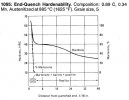Hi,
Could someone please clarify a few things for me.
So let’s start with the homon. I read on some posts here that the steel has to be up to a maximum of 0.4% Mn to get a hamon, anything higher, no go.
Also, when the Mn is low, the steel is considered shallow hardening and when high, like in the O1 or A2 for example it is considered deep hardening.
Does this mean that steel considered shallow hardening will give a hamon?
I understand that the hamon is formed between areas where the hardness changes. But how is that related with shallow hardening?
And last, when talking about shallow hardening, how shallow is that, say goes no more than 0.8” deep or what is the depth ?
I was recently trying to get some 1095 in 0.250” thick, for a Tanto, but I was told that they don’t carry this thickness since it doesn’t harden deep enough. Is this correct?
Please correct me and I apologize for my confusion.
Thanks in advance,
Constantin
Could someone please clarify a few things for me.
So let’s start with the homon. I read on some posts here that the steel has to be up to a maximum of 0.4% Mn to get a hamon, anything higher, no go.
Also, when the Mn is low, the steel is considered shallow hardening and when high, like in the O1 or A2 for example it is considered deep hardening.
Does this mean that steel considered shallow hardening will give a hamon?
I understand that the hamon is formed between areas where the hardness changes. But how is that related with shallow hardening?
And last, when talking about shallow hardening, how shallow is that, say goes no more than 0.8” deep or what is the depth ?
I was recently trying to get some 1095 in 0.250” thick, for a Tanto, but I was told that they don’t carry this thickness since it doesn’t harden deep enough. Is this correct?
Please correct me and I apologize for my confusion.
Thanks in advance,
Constantin

